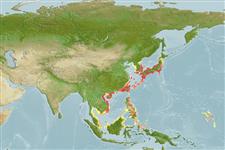Environment: milieu / climate zone / depth range / distribution range
Ecology
Marine; reef-associated; non-migratory; depth range 2 - 15 m (Ref. 7247). Subtropical
Western Pacific: southern Japan, Ryukyu Islands, Taiwan, and China.
Size / Weight / Age
Maturity: Lm ? range ? - ? cm
Max length : 17.0 cm TL male/unsexed; (Ref. 9710)
Adults inhabit inshore and offshore coral or rocky reefs (Ref. 7247). Oviparous, distinct pairing during breeding (Ref. 205). Eggs are demersal and adhere to the substrate (Ref. 205). Males guard and aerate the eggs (Ref. 205). Diurnal species (Ref. 52881).
Life cycle and mating behavior
Maturities | Reproduction | Spawnings | Egg(s) | Fecundities | Larvae
Oviparous, distinct pairing during breeding (Ref. 205). Eggs are demersal and adhere to the substrate (Ref. 205). Males guard and aerate the eggs (Ref. 205).
Iwatsubo, H. and H. Motomura, 2013. Redescriptions of Chromis notata (Temminck and Schlegel, 1843) and C. kennensis Whitley, 1964 with the description of a new species of Chromis (Perciformes: Pomacentridae). Spec. Div. 18:193-213. (Ref. 94774)
IUCN Red List Status (Ref. 130435)
Threat to humans
Harmless
Human uses
Tools
Special reports
Download XML
Internet sources
Estimates based on models
Preferred temperature (Ref.
123201): 18.9 - 28.5, mean 24.9 °C (based on 360 cells).
Phylogenetic diversity index (Ref.
82804): PD
50 = 0.5000 [Uniqueness, from 0.5 = low to 2.0 = high].
Bayesian length-weight: a=0.01622 (0.00961 - 0.02738), b=3.04 (2.90 - 3.18), in cm total length, based on LWR estimates for this species & Genus-body shape (Ref.
93245).
Trophic level (Ref.
69278): 3.4 ±0.45 se; based on food items.
Resilience (Ref.
120179): Medium, minimum population doubling time 1.4 - 4.4 years (Preliminary K or Fecundity.).
Fishing Vulnerability (Ref.
59153): Low vulnerability (10 of 100).
Nutrients (Ref.
124155): Calcium = 55.4 [23.5, 94.5] mg/100g; Iron = 0.725 [0.394, 1.323] mg/100g; Protein = 19.1 [17.9, 20.3] %; Omega3 = 0.16 [0.08, 0.30] g/100g; Selenium = 9.86 [4.42, 21.57] μg/100g; VitaminA = 83.1 [21.4, 321.0] μg/100g; Zinc = 0.863 [0.523, 1.383] mg/100g (wet weight);
